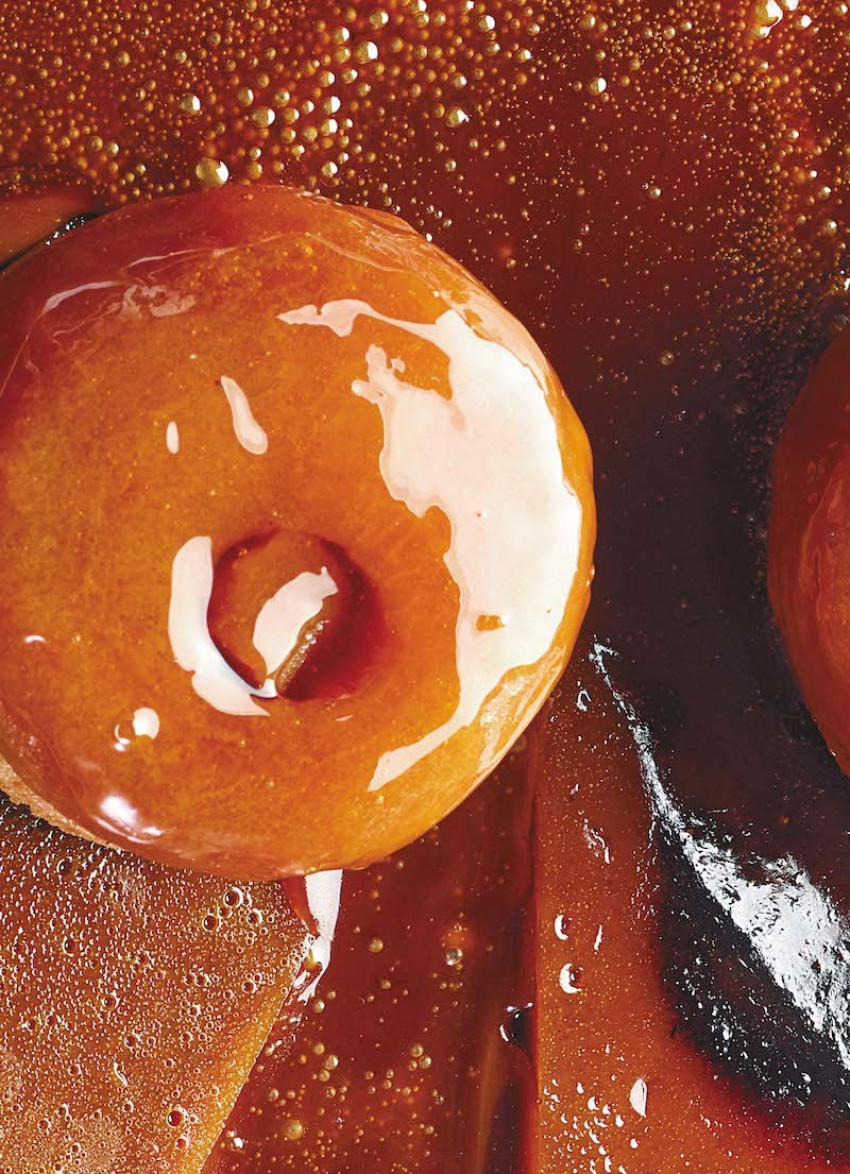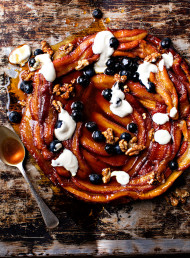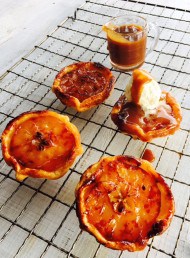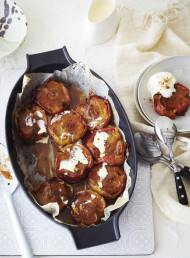Dominique Ansel's Apple Tarte Tatin
Photography by Thomas Schauer .
This week, amateur baker David Parker reviewed Dominique Ansel's new cookbook, The Secret Recipes from the World Famous New York Bakery, by attempting to recreate this Apple Tarte Tatin. Here is the glorious original...
INGREDIENTS
Special Tools:
Stand mixer with whisk and paddle attachments
Ruler
Six 3-inch (7.5 cm) round cake tins or one 8-inch (20 cm) round cake tin
Candy thermometer
Vegetable peeler
Apple corer
Sablé Breton Cookies:
Egg yolks (large), 2 each (40 grams)
Granulated sugar, 6½ tablespoons (85 grams)
Salted butter, (84% butterfat) 4½ tablespoons (65 grams)
Plain flour, ¾ cup (90 grams)
Baking powder, 1½ teaspoons (5 grams)
Kosher salt, ½ teaspoon (1 gram)
Caramelised Apples:
Granulated sugar, ⅔ cup (137 grams)
Water ¼ cup + 1½ tablespoons (60 grams)
Unsalted butter (84% butterfat) cut in small dice, 3 tablespoons (35 grams)
Gala apples, 7 for 6 individual tarts; 8 for a large tart
Crème fraîche (for serving, optional)
I love making this recipe because it’s 80 per cent gorgeous, juicy fruit.
Skill level: Beginner
Time: 20 minutes one day before; 2 hours the day of
Yield: 6 individual 3-inch (7.5 cm) tarts or 1 large 8-inch (20 cm) tart
Timeline
One day before: Make dough
The day of: Bake sablé cookies; make caramelised apples; assemble
METHOD
One Day Before: Make Dough
1. Combine the egg yolks and granulated sugar in a stand mixer fitted with a whisk. Whip on high speed for 2 to 3 minutes until the mixture becomes light and fluffy.
2. Soften (but don’t melt!) the butter in the microwave. Reduce the mixer speed to low and mix in the butter.
3. Remove the bowl from the mixer. Using a rubber spatula, fold in the flour, baking powder and salt. Mix just until the flour is incorporated, making sure to scrape down the sides of the bowl with a rubber spatula. The dough should be firm yet pliable.
4. On a piece of baking paper, draw a rectangle a little larger than 6 by 9 inches (15 by 23 cm) with a pencil if making individual tarts, or an 8-inch (20 cm) square if making a large tart. Flip the baking paper over on the work surface. Transfer the dough to the centre of the outline. With an offset spatula or your fingers, shape it into a square ¼ inch (6 mm) thick. Cover with another piece of baking paper. Using a rolling pin with steady, even pressure, push the dough from the middle outward to the edges of the outline. When the dough is rolled evenly and fits the outline, place on a baking tray, still between the two pieces of baking paper, and refrigerate overnight to rest.
The Day Of: Bake Sablé Cookies
1. Place a rack in the centre of the oven and preheat the oven to 350°F (175°C) for conventional or 325°F (160°C) for convection. Line a baking tray with baking paper.
2. Remove the sablé dough from the refrigerator and peel off the top layer of baking paper. Using a cake tin as a guide, trace around the rim with a paring knife and cut out 6 individual cookies or 1 large cookie. Remove the excess dough. Transfer the sablé cookies to the baking tray.
3. Bake the sablé cookies on the centre rack for 8 minutes. Rotate the tray 180 degrees and bake for 8 minutes more or until the sablé cookies turn golden brown. The single large cookie might take a little longer. Transfer the sablé cookies, still on the baking paper, to cool.
Make Caramelised Apples
1. Place a rack in the centre of the oven and preheat the oven to 350°F (175°C) for conventional or 325°F (160°C) for convection.
2. Combine the granulated sugar and water in a medium saucepan and bring to a boil over medium heat. Cook without stirring until the caramel reaches 350ºF (175ºC) and turns a dark amber.
3. Whisk the butter into the caramel. Be careful! The butter will foam and the caramel will rise in the saucepan. Continue to whisk until all the butter has been incorporated and the caramel is smooth.
4. Divide the caramel equally among the cake tins. It should fill each pan about ⅜ inch (1 cm) deep.
5. Peel and core the apples. If making individual tarts, slice 1 apple into 6 segments. Place 1 whole apple into each small tin. Push 1 segment into the centre of each whole apple. For a large tart, place 1 whole apple in the centre of the large tin. Cut 6 apples in half vertically and place the halves, standing up, in a circle around the whole apple. Slice the remaining apple into 6 segments and fill the spaces between apples.
6. Transfer the cake tins to a baking tray and bake on the centre rack for 30 minutes. Remove from the oven and gently press each apple down with an offset spatula. Return the apples to the oven. Repeat this process 3 or 4 more times. When finished, the apples will have lost half of their size and turned a dark amber. A light skin will have formed on top of the apple, which will become the bottom when unmoulded.
7. Let the caramelised apples cool to room temperature, then refrigerate for an hour for the caramel to set and thicken.
Assemble
1. To unmould the apples, warm the outside and bottom of the tin by placing it directly on the stovetop over medium heat for 30 seconds. (Alternatively, place it in the oven at 350°F [175°C] for 3 minutes.) Using a small offset spatula or a fork, gently pull the apples away from the edge of the mould.
2. Invert each tin and slide the apple onto a sablé cookie. Serve immediately.
Serving Instructions: Serve warm or at room temperature. A dollop of crème fraîche is a great accompaniment.
Storage Instructions: Assembled tarts should be consumed the day of. Caramelised apples can be kept in a closed airtight container in the refrigerator for 2 days. Sablé Breton cookies can be kept in an airtight container at room temperature for up to 5 days.

This is an edited extract from Dominique Ansel: The Secret Recipes from the World Famous New York Bakery, by Dominique Ansel, published by Murdoch Books, NZ, RRP$49.99, available now.
Keep up to date with
dish weekly recipes,
food news, and events.
latest issue:
Issue #120
As the days become shorter, and the nights cooler, the latest issue is perfectly timed to deliver delicious autumn dishes. From recipes using fresh seasonal produce such as feijoas and apples, to spectacular soothing soups and super-quick after-work meals in our Food Fast section, we’ve got you covered. With Easter on the horizon, we feature recipes that will see you through breakfast, lunch and dinner over a leisurely weekend holiday, and whip up chocolatey baking treats sure to please. We round up delicious dinners for two and showcase a hot new Korean cookbook before heading south to Dunedin to check out all that’s new in food and dining.The latest issue of dish is on sale NOW at all good bookstores and supermarkets – don’t miss it!







